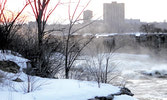Deschênes Rapids Ruins
Municipal file languishes

It is unclear what is going on with the municipal project to designate the Deschênes Rapids as a heritage site and to protect the ruins.
“The only update is that work hasn’t begun. I have been emailing the responsible people in the Gatineau administration every couple of months for updates and it is always the same answer, ‘not started yet’,” Howard Powles, Deschênes Residents’ Association (DRA) President, told the Bulletin.
Contacted by the Bulletin, a city spokesperson said that the actions scheduled in 2016 for that project are pushed to 2017.
“The Quebec Ministry of Transport (MTQ) must present their recommendations to us regarding the Deschênes Rapids in early 2017,” said a city spokesperson, without going into more details.
The MTQ does own the island and the ruins and is therefore responsible for the area’s security.
“In the spring of 2015, the MTQ presented to city officials different scenarios to ensure the safety of residents. Among those considered were the demolition of the ruins, the addition of riprap or the installation of a boom (barrier),” said Martine Perreault, MTQ spokesperson. For the MTQ, the safest option is the demolition of the ruins.
“The goal is to eliminate the hazard to prevent further accidents. Since 2007, there have been 20 safety interventions in the area and six individuals have died or gone missing. Contrary to what signs stipulate in the area, some people still venture near the ruins,” added Perreault. “A meeting is scheduled this November with the city to discuss the situation. The question is still being analyzed and no decision has been taken,” said Perreault.
Since the presentation, there has not been much action on the file. According to Perreault, the ball is in the city’s court. The reason why no action has been taken is likely because there’s no consensus on the matter.
For example, Deschênes councillor Richard Bégin is against the demolition of the ruins of the old dam structure built at the turn of the 19th century to produce hydroelectric power from the rapids.
“The rapids are not safe and people should not venture there. This does not mean we should destroy the ruins. Even the First Nations portaged around them because of the danger they posed,” said Bégin, who’s also president of the Quebec Federation of historical societies.
On the other hand, Mike Duggan, Lucerne councillor, wants the “dangerous” ruins demolished.
“I give considerable weight to the natural heritage of the river, and see the dam ruins as an incursion. The fact that the dam is no longer in operation means that it only serves as a reminder of the built human heritage, and a poor one at that, since only some footings remain,” said Duggan.
In 2012, the DRA worked with historian Michelle Guitard to produce a report to designate the Deschênes Rapids as an historic site. The idea was to encourage the municipality to recognize the rapids as a heritage site. Classifying the rapids as a historic site will put them under the city’s protection regulation for historic monuments, protecting them from unfit modifications and destruction, thanks to the adoption of the Cultural Heritage Act Bill in 2011 which permits the recognition of immaterial and cultural landscapes.
“You may recall that Gatineau set aside $45,000 for planning at the rapids in the 2015 budget, but we have seen no action on this either. Our Association had a Forum on October 22 to identify Deschênes issues and the need to “create a destination” at the rapids was top of mind for the participants. Moreover, contacting the city to push on planning was identified as a priority,” explained Powles.
Initially, the project was slated to receive close to $700,000, but because of provincial budget cuts, the city was forced to reconsider the amount.


